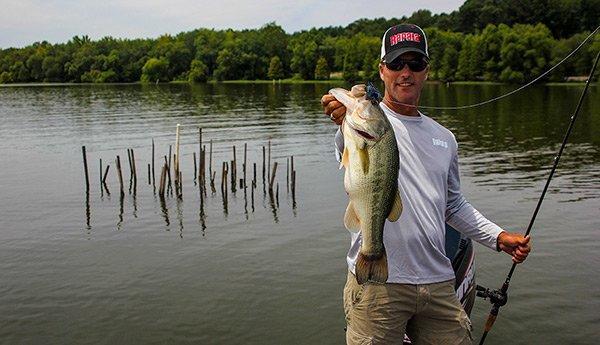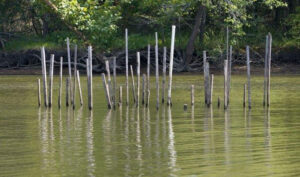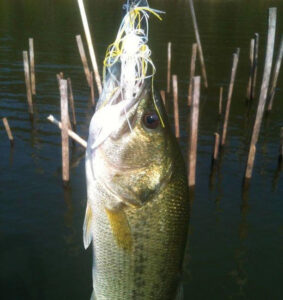Last night we pulled into a calm pocket to shoot a few photos of some bass we fished out deep for an upcoming article on drop shotting. Wind and waves make it hard to shoot good photography when bass fishing. However, while shooting photos in this shallow calm pocket we noticed that there was a ton of baitfish in and around a common piece of cover on the lake that bass love — stake beds.
What are Stake Beds
Check out this video of stake bed fishing!
Crappie guides and avid crappie angler place stake beds or cribs as some folks call them in shallow water so the crappie will have something to relate to when they come shallow to spawn and make them a little easier to target. In the spring and fall, these man-made pieces of cover can be dynamite holding spots for shallow feeding bass.
Typically the stake beds consist of a pallet with several planks of wood or pvc pipes standing vertically off the pallet. When placed in the water it makes a vertical piece of cover that attracts various types of forage and in turn larger gamefish.
The square cut wood often found on these structures will collect with moss and a soften as they get water logged. That can make them extremely snagging to artificial bass lures.
What to Throw in Stake Beds
Single hook lures like jigs, spinnerbaits, chatterbaits and even buzzbaits can be good along with texas-rigged plastics. But I’ve found that if you’re patient and will work the bait through, a square-billed crankbait is dynamite for this fishing when the water is off-colored.
How to Fish Stake Beds
Depending on the water clarity, you can fish it like a piece of flipping and pitching cover or you can fish it like standing timber or pencil reeds with reaction baits. If the water is muddy and shallow and it’s in the fall, the bass often use these stake beds as feeding zones ambushing prey. This is when a spinnerbait or chatterbait pitched in and around the beds can be very deadly. The key is fishing the lanes.
On this afternoon, as I approached the first stake bed, I noticed baitfish skittering and dodging swirls in the water, a tell tale sign of bass being present. I picked up a white and chartreuse Z-Man Chatterbait and flung it to one side of the stake bed. No takers. Then I bombed a cast down the other side. Still no takers. So I moved in closer and began making a series of pitches through “lanes” in the standing wood.
As you circle around the stake bed, lanes will open up where you can see a clear path through the stake bed with one pitch. Just reel it through the whole bed. First pitch I made through the stake bed, the Chatterbait disappeared. Second cast another bass. Rounded to the backside of it and found another lane and landed another bass. After two stops on the same stake bed, I landed six bass on a Chatterbait and one pitching some sort of creature bait.
On the flipping and pitching side, two approaches work well. One is to pitch to the outside edges and then work your way to the middle. The other approach is to make your first pitch to the most likely spot which is generally the densest part of the stake bed. The key is to think about your exit strategy. Whenever you pitch the bait, make sure you have a way to get it back when a fish bites. Often you can slowly and quietly move to the other side of the stake bed and hit it from another angle.
Stake beds are like stumps but can support many more bass than a single stump. The bass won’t always be in this type of cover, but usually when you find some bass in stake beds you can fish bass in that pattern all over a lake and do well. We’ve taken tournament winning big bass from this cover so it’s worth your fishing time.













